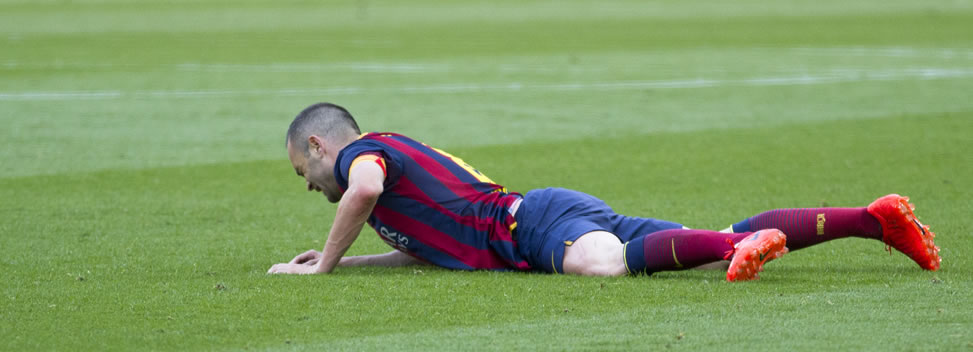Concussion: the hidden danger with head injuries
- August 12, 2014
- Paul Crompton

Top Andrés Iniesta image credit to Nathan Rupert on Flickr
Concussion is a constant threat in sport, but many coaches don't know what it is, how to spot it or how to treat it. That's why in this blog I look at what impact the new Premier League directive may have at grassroots level and also give you tips to help you be better prepared to deal with concussion.
Concussion: What the new directive may mean for you team
The new FA directive means footballers will be stopped from playing if a sideline doctor decides he is unfit to do so after a head collision, with the player and manager no longer having any say in the matter. This follows a number of high-profile head injuries at the World Cup in Brazil, where concussed players were allowed to continue playing (such as Germany's Christoph Kramer in the World Cup Final match between Germany and Argentina).
The new directive is fine for mega rich Premier league teams but how can amateur clubs afford to have a doctor waiting on the side lines to examine a player following a clash of heads? In short they can't.
One possible solution for grassroot coaches might be to have the FA run a free Youtube course (similar to the video below) to educate coaches how to recognise and respond to head injuries. It would be one way on ensuring coaches are able to identify the symptoms of concussion and ensure the player is correctly cared for on the sidelines.
Football stars, including former England captain Steven Gerrard, give advice and tips on how to spot concussion and what you should do if you notice the symptoms
It's about time football has caught up with Rugby Union where concussed U6 to U19 players must rest 23 days before returning and adults at least 19 days (unless given the all clear by a medical practitioner) and America's NFL which have already introduced strict laws governing head collisions.
No doubt the new directive is a positive step forward and it's great to see the FA launch a campaign to raise awareness of the dangers. Let's hope this directive filters down soon to protect grassroot level players as well.
Those Premier League Football Guidelines in more detail
The new guidelines state a player MUST undergo a pitch or touchline concussion risk assessment if involved in any head collision whether knocked unconscious or not, and in the case of a confirmed or suspected loss of consciousness is NOT allowed to return to the field. A video replay, available pitch-side or in the players' tunnel, could also be used to clarify the course of events.
The Guidelines include:
- A player suffering a head injury must now leave the pitch
- The club doctor makes the final decision as to whether a player continues to play, not team managers or coaching staff
- Home teams must now have a third "tunnel" doctor on match-days to support the work of the doctors for both sides
- The "tunnel" doctor will serve as an extra pair of eyes to spot potential concussions and watch TV replays to see the severity of incidents
- The Premier League is to employ its own doctor to conduct research and liaise with all 20 club doctors in the league on key medical matters
- All Premier League players are to undergo baseline neurological assessments as part of their annual medical check-up to help doctors measure their recovery time if they suffer a concussion

Collision near the goal
(image credit to woodleywonderworks on Flickr)
How you can spot and react to concussion
Do you have the knowledge and ability to recognise and deal with a head injury? Do you know what concussion is? In medical terms it is a minor traumatic brain injury following a sudden but short-lived loss of mental function after a blow or other injury to the head. Concussion is the most common but least serious type of brain injury.
Symptoms include:
- memory loss
- disturbances in vision, such as 'seeing stars'
- headache
- nausea
- loss of balance
- confusion, such as being unaware of your surroundings
- feeling stunned or dazed
What to do if a player is concussed:
There are a number of things to help relieve concussion symptoms, including:
- Apply an ice pack to the injury to reduce swelling
- Take paracetamol to control any pain
- Avoid drinking alcohol (applies to over 18s only of course!)
- Do not play contact sports for at least three weeks without talking to your GP
- Ensure the player has someone with him/her for the first 48 hours after the injury, in case you experience more serious follow-up symptoms
Recovery:
After experiencing concussion, a period of careful monitoring is needed. This can be for several days or weeks, depending on how serious the concussion was.
This is because the symptoms of concussion could also be symptoms of a more serious condition, such as:
- mental confusion
- drowsiness that goes on for longer than an hour
- difficulty speaking
- loss of balance
- persistent headache
The NHS advises if symptoms persist or if someone in your care shows any of the above signs to visit a GP or the nearest accident and emergency (A&E) department as soon as possible.
 Liked this blog? Share it with a friend using the links below or click the print button!
Liked this blog? Share it with a friend using the links below or click the print button!